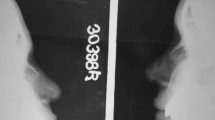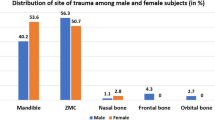Abstract
Aim
Maxillofacial trauma when associated with concomitant injuries has a significant potential for increased morbidity. This study aims to identify the causes of trauma, evaluate the types of associated injuries and to highlight the significance of multi professional collaboration in sequencing of treatment.
Patients and Methods
A total of 300 patients who reported to the casualty of a tertiary Hospital in Karnataka with facial fractures were enrolled.
Results
Associated injuries were sustained by 162 patients. The predominant aetiology was the Road Traffic Accident with maximum number of patients in the age group of 20–29 and a male to female ratio of 10.1:1. The mandible was the most frequently fractured bone. Head injury was the most common associated injury. The mortality rate was 0.66%. The mean ISS and GCS values among the patients who sustained associated injuries along with maxillofacial trauma were higher and lower respectively, as compared to those without associated injuries with a statistically significant difference (p < 0.001).
Conclusion
Implementation of strict road safety measures in the rural and interior regions of South India, to prevent morbidity and mortality due to road traffic accidents is essential. Injuries to the facial skeleton must be approached with the knowledge of probable associated injuries that could have been incurred.


Similar content being viewed by others
References
Down KE, Boot DA, Gorman DF (1995) Maxillofacial and associated injuries in severely traumatized patients: implications of a regional survey. Int J Oral Maxillofac Surg 24:409–412
American Association For Automotive Medicine (1985) The Abbreviated Injury Scale. Arlington Heights. American Association for Automotive Medicine, Arlington Heights, IL, USA
Ajike SO, Adebayo ET, Amanyiewe EU, Ononiwu CN (2005) An epidemiologic survey of maxillofacial fractures and concomitant injuries in Kaduna, Nigeria. Niger J Surg Res 7(3):251–255
Khan M, Din QU, Murad N, Shah SMA (2010) Maxillofacial and associated fractures of the skeleton—a study. Pak Oral Dent J 30(2):313–316
Obuekwe ON, Etetafia M (2004) Associated injuries in patients with maxillofacial trauma. Analysis of 312 consecutive cases due to road traffic accidents. JMBR Peer Rev J Biomed Sci 3(1):30–36
Scherbaum Eidt JM, De Conto F, DeBortoli MM, Engelmann JL, Rocha FD (2013) Associated injuries in patients with maxillofacial trauma at the Hospital São Vicente dePaulo, Passo Fundo, Brazil. J Oral Maxillofac Res 4(3):1–8
Kamath RA, Bharani S, Hammannavar R, Ingle SP, Shah AG (2012) Maxillofacial trauma in Central Karnataka, India: an outcome of 95 cases in a Regional Trauma Care Centre. Craniomaxillofac Trauma Reconstr 5(4):197–204
Gagov L, Rubiev M, Deliverska E (2012) The role of alcohol involvement in maxillofacial trauma. J IMAB Annu Proc Sci Pap 18(2):147
Leles JLR, Santos ÊJD, Jorge FD, Silva ETD, Leles CR (2010) Risk factors for maxillofacial injuries in a Brazilianemergency hospital sample. J Appl Oral Sci 18(1):23–29
Ascani G, Di Cosimo F, Costa M, Mancini P, Caporale C (2014) Maxillofacial fractures in the province of Pescara, Italy: a retrospective study. ISRN Otolaryngol 2014(Article ID 101370):4
Al Ahmed HE, Jaber MA, Abu Fana SH, Karas M (2004) The pattern of maxillofacial fractures in Sharjah, United Arab Emirates: a review of 230 cases. Oral Surg Oral Med Oral Pathol Oral Radiol Endodontol 98:166–170
Haug RH, Prather J, Indresano AT (1990) An epidemiologic survey of facial fractures and concomitant injuries. J Oral Maxillofac Surg 48:926–932
Punjabi SK, Khan M, Qadeer-ul-Hassan ZUN (2012) Associated injuries with facial trauma—a study. Jlumhs 11(2):60
Akama MK, Chindia ML, Macigo FG, Ghuthua SW (2007) Pattern of maxillofacial and associated injuries in road traffic accidents. East Afr Med J 84:287–290
Holmes PJ, Koehler J Jr, McGwin G, Rue LW III (2004) Frequency of maxillofacial injuries in all-terrain vehicle collisions. J Oral Maxillofac Surg 62:697–701
Plaisier BR, Punjabi AP, Super DM, Haug RH (2000) The relationship between facial fracturesand death from neurologic injury. J Oral Maxillofac Surg 58:708–712
Udeabor S, Akinmoladun VI, Olusanya A, Obiechina A (2014) Pattern of midface trauma with associated concomitant injuriesin a Nigerian Referral Centre. Niger J Surg 20(1):26–29
Keenan HT, Brundage SI, Thompson DC, Maier RV, Rivara FP (1999) Does the faceprotect the brain? A case control study of traumatic brain injury and facialfractures. Arch Surg 134:14–17
Hampson D (1995) Facial injury: a review of biomechanical studies and test procedures for facial injury assessment. J Biomech 28:1–7
Zhou H-H, Liu Q, Yang R-T, Li Z, Li Z-B (2015) Traumatic head injuries in patients with maxillofacial fractures: a retrospective case–control study. Dent Traumatol 31:209–214
Peter ward booth, Stephen A Schendel, Jarg-Erich Hausamen. vol 1, 2nd edn. p 13
Işik D, Gönüllü H, Karadaş S, Koçak ÖF, Keskin S, Garca MF, Eşeoğlu M (2012) Presence of accompanying head injury in patients with maxillofacial trauma. Ulus Travma Acil Cerrahi Derg 18(3):200–206
Brasileiro BF, Passeri LA (2006) Epidemiological analysis of maxillofacial fractures in Brazil: a 5-year prospective study. Oral Surg Oral Med Oral Pathol Oral Radiol Endodontol 102:28–34
Thorén H, Snäll J, Salo J, Suominen-Taipale L, Kormi E, Lindqvist C, Törnwall J (2010) Occurrence and types of associated injuries in patients with fractures of the facial bones. J Oral Maxillofac Surg 68(4):805–810
Roccia F, Cassarino E, Boccaletti R et al (2007) Cervical spine fractures associated with maxillofacial trauma: an 11-year review. J Craniofac Surg 18:1259
Elahi MM, Brar MS, Ahmed N et al (2008) Cervical spine injury in association with craniomaxillofacial fractures. Plast Reconstr Surg 121:201
Merritt RM, Williams MF (1997) Cervical spine injury complicating facial trauma: incidence and management. Am J Otolaryngol 18:235
Ardekian L, Rosen D, Klein Y, Peled M, Michaelson M, Laufer D (1998) Life-threatening complications and irreversible damage following maxillofacial trauma. Injury 29(4):253–256
Hackl W, Hausberger K, Sailer R, Ulmer H, Gassner R (2001) Prevalence of cervical spine injuries in patients with facial trauma. Oral Surg Oral Med Oral Pathol Oral Radiol Endodontol 92:370–376
Jaiswal A, Tanwar YS, Habib M, Jain V (2013) First rib fractures: not always a hallmark of severetrauma a report of three cases. Chin J Traumatol 16(4):251–253
Gad MA, Saber A, Farrag S, Shams ME, Ellabban GM (2012) Incidence, patterns, and factors predicting mortality of abdominal injuries in trauma patients. N Am J Med Sci 4(3):129–134
Bowley D, Boffard K (2002) Pattern of injury in motor vehicle accidents. World Wide Wounds
Author information
Authors and Affiliations
Corresponding author
Ethics declarations
Conflict of interest
All the above mentioned authors declare that, he/she do not have any conflict of interest. All the authors declare that they have no conflict of interest.
Ethical Standards
All procedures performed in studies involving human participants were in accordance with the ethical standards of the institutional and/or national research committee and with the 1964 Helsinki declaration and its later amendments or comparable ethical standards.
Informed consent
Informed consent was obtained from all individual participants included in the study.
Rights and permissions
About this article
Cite this article
Patil, S.G., Munnangi, A., Joshi, U. et al. Associated Injuries in Maxillofacial Trauma: A Study in a Tertiary Hospital in South India. J. Maxillofac. Oral Surg. 17, 410–416 (2018). https://doi.org/10.1007/s12663-017-0998-7
Received:
Accepted:
Published:
Issue Date:
DOI: https://doi.org/10.1007/s12663-017-0998-7




